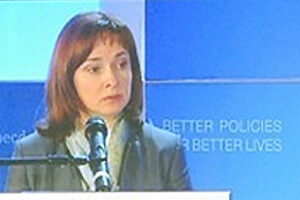Russia’s Ailing Consumers Keep Door Open for Rate Cuts

(Bloomberg – bloomberg.com – Ott Ummelas, Anna Andrianova – October 18, 2015)
There may be a silver lining for the Bank of Russia in another batch of grim consumer data.
While Governor Elvira Nabiullina has set a course for monetary easing to match slowing inflation, policy makers last month paused their easing cycle for the first time in 2015. The scales may be tipping in favor of another cut this year as Russia’s consumer economy continues to weaken. Wages adjusted for inflation fell for an 11th month in September and retail sales contracted the most in 16 years, the Federal Statistics Service in Moscow said Monday in a statement.
“There are strong disinflationary trends, including falling retail sales, vehicle sales, wages, and household debt,” Per Hammarlund, the chief emerging-markets strategist at SEB AB in Stockholm, said by e-mail before the data release. “This weakness will give plenty of room for the” central bank “to cut rates, as long as oil prices hold up.”
Russian policy makers have struggled to concoct the right policy mix to steer the country out of its longest recession in two decades. A fresh bout of ruble weakness forced the central bank to hold off on easing policy after it already rolled back most of a December emergency rate increase. With international sanctions and low oil prices shackling the economy of the world’s largest energy exporter, Standard & Poor’s last week forecast a deeper contraction as it predicts private consumption will remain weak next year.
Ruble Decline
Since last month’s rate decision, the ruble has gained 10 percent against the dollar amid a revival in emerging-market risk appetite. The ruble has depreciated about 35 percent against the dollar in the past 12 months, the second-worst performer behind the Brazilian real among 24 emerging-market currencies tracked by Bloomberg. It traded 1.5 percent weaker at 62.2630 rubles per dollar at 4.08 p.m. Monday. Forward-rate agreements are signaling 40 basis points of cuts in borrowing costs during the next three months, the biggest bets since July.
September real wages declined 9.7 percent from a year ago after a revised 9 percent drop in August, the statistics service said. The median estimate of 14 economists surveyed by Bloomberg was 9.8 percent. Retail sales dropped 10.4 percent, the most since August 1999, and disposable incomes shrank 4.3 percent.
VTB analysts Alexander Isakov and Petr Grishin said in a note Oct. 15 that “further proof of demand weakness,” including unemployment approaching 6 percent, an annual decline in real wages closer to 11 percent or an accelerating decline in investments is needed to shift the balance toward a 50 basis-point rate cut at the central bank meeting on Oct. 30. Other conditions include the ruble trading at about 62 against the dollar and the budget stance being kept tight, they said.
The unemployment rate unexpectedly declined to 5.2 percent from 5.3 percent, compared with the 5.4 percent median estimate of 12 economists. Fixed-capital investment dropped 5.6 percent last month, the 21st consecutive negative reading, making it the longest such stretch since at least 1995, when Bloomberg started compiling the figures.
“We now anticipate a weakness in private consumption to extend into 2016, and an only marginal recovery in capital spending next year, helped by improved corporate profit margins and a slowdown in deleveraging,” S&P senior economist Tatiana Lysenko said in a report on Oct. 15. The credit evaluator now sees Russia’s economy contracting 3.6 percent this year, followed by 0.3 percent growth in 2016, she said.
Article ©2015 Bloomberg L.P. All Rights Reserved. Article also appeared at bloomberg.com/news/articles/2015-10-18/russia-s-ailing-consumers-keep-door-open-for-nabiullina-to-ease
